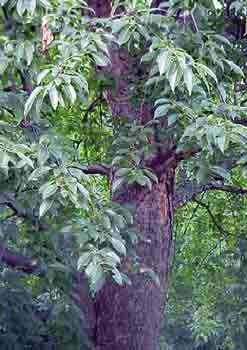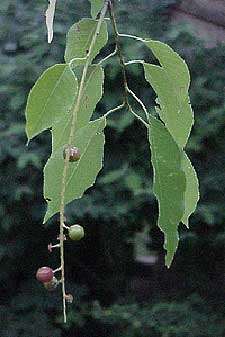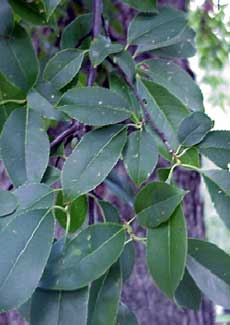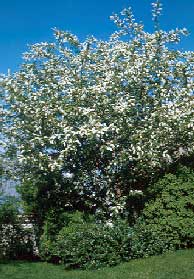 Black Cherry - Prunus serotina
Black Cherry - Prunus serotina
Rose Family (Rosaceae)
Black cherry is the largest cherry native to Kentucky. It grows best in forests with deep soils; however, trees occur in hedgerows and along county roads because birds spread the seeds. Most large trees have been harvested for their valuable wood that is used for fine woodworking. The Kentucky champion tree is in Clark County and is 95 feet tall.
- Native habitat: Ontario to North Dakota, south to Florida and Texas.
- Tree size: Reaches a height of 50 to 60 feet.
 Flower and fruit: White flowers are 1/3-inch wide and are borne in 4- to 6-inch-long pendulous racemes in May. Red, 1/3-inch fruits ripen to black in August and September.
Flower and fruit: White flowers are 1/3-inch wide and are borne in 4- to 6-inch-long pendulous racemes in May. Red, 1/3-inch fruits ripen to black in August and September.- Leaf: Leaves are simple, alternate, 2 to 5 inches long and 1 to 13/4 inches wide. Leaves are dark green in summer and yellow to red in fall.
- Hardiness: Winter hardy to USDA Zone 3.
Additional information: The fruit of black cherry has a bitter-sweet flavor and is used to make jelly and wine. Birds, squirrels, deer, raccoon, black bears, ruffed grouse, opossum and turkey are among the animals that eat the fruit of black cherry. The bark, leaves and twigs of this tree are poisonous to livestock, although deer can eat the leaves without harm. Wilted leaves of black cherry are more poisonous than fresh leaves.
 The wood of black cherry is valuable for making furniture and cabinets. The strong, hard wood of this tree is close-grained. It is also used to make paneling, veneers, interior trim, toys and scientific instruments. In the southern Appalachian Mountains, the bark of black cherry has been used in cough medicines and sedatives. Pioneers in the Appalachians used the fruit of black cherry to flavor rum or brandy.
The wood of black cherry is valuable for making furniture and cabinets. The strong, hard wood of this tree is close-grained. It is also used to make paneling, veneers, interior trim, toys and scientific instruments. In the southern Appalachian Mountains, the bark of black cherry has been used in cough medicines and sedatives. Pioneers in the Appalachians used the fruit of black cherry to flavor rum or brandy.
The national champion black cherry, located in Tennessee in Great Smoky Mountains National Park, is 134 feet tall with a 70-foot spread. The Kentucky state champion is 95 feet tall with an 18-foot spread and is located in Clark County. This tree was introduced into the landscape in 1629.


